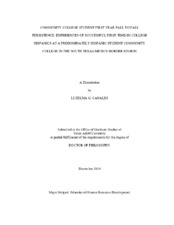| dc.contributor.advisor | Dooley, Larry M. | |
| dc.creator | Canales, Luzelma | |
| dc.date.accessioned | 2012-02-14T22:18:42Z | |
| dc.date.accessioned | 2012-02-16T16:12:20Z | |
| dc.date.available | 2012-02-14T22:18:42Z | |
| dc.date.available | 2012-02-16T16:12:20Z | |
| dc.date.created | 2010-12 | |
| dc.date.issued | 2012-02-14 | |
| dc.date.submitted | December 2010 | |
| dc.identifier.uri | https://hdl.handle.net/1969.1/ETD-TAMU-2010-12-8862 | |
| dc.description.abstract | As the United States and Texas become increasingly dependent on the success of Hispanics in higher education based on degree attainment, decision-makers and policy-makers are looking for strategies for addressing the education attainment needs of the Hispanic population. The purpose of this naturalistic inquiry was to understand 1) the barriers experienced by successful first year (fall to fall) first-time-in-college Hispanic students at a predominately Hispanic student community college on the South Texas/Mexico Border Region, 2) the expertise/knowledge required to successfully overcome these barriers during the first year (fall to fall) in college, and 3) based on these findings, offer suggestions and recommendations for addressing the barriers experienced by Hispanic students enrolled in such community colleges. More specifically, the researcher examined the barriers experienced by students during the first year of college, and based on their experiences, the expertise required to overcome those barriers. The study utilized Padilla‘s (1991) Student Success Model as the primary theoretical framework for the study.
The data analysis led to the identification of six barrier categories, which included: 1) transition from high school to college; 2) personal and family commitments; 3) institutional support; 4) student accountability; 5) instructor issues; and 6) developmental studies/college readiness. In the findings, I include the role of general college knowledge and academic college readiness in students successfully completing the first year (fall to fall) of college. The researcher utilized the results of the study to develop the Community College Student Success Model for First-Time-in-College Students, which was adapted from Padilla (1991, 2001) and Padilla, Treviño, Gonzalez, and Treviño (1996). The researcher recommends utilizing Lynham‘s (2002) General Method of Theory-Building to move towards the development of a theory for Hispanic student success in predominately Hispanic community colleges. The researcher also recommended the development and implementation of collaborative programs and services between the public school districts and the community college for facilitating the acquisition of general college knowledge by high school students before they graduate from high school. | en |
| dc.format.mimetype | application/pdf | |
| dc.language.iso | en_US | |
| dc.subject | Community College | en |
| dc.subject | Hispanic Student Success | en |
| dc.subject | Persistence | en |
| dc.subject | College Knowledge | en |
| dc.subject | College Readiness | en |
| dc.subject | Barriers to Student Success | en |
| dc.title | Community College Student First Year Fall to Fall Persistence: Experiences of Successful First-Time-In-College Hispanics at a Predominately Hispanic Student Community College in the South Texas/Mexico Border Region | en |
| dc.type | Thesis | en |
| thesis.degree.department | Educational Administration and Human Resource Development | en |
| thesis.degree.discipline | Educational Human Resource Development | en |
| thesis.degree.grantor | Texas A&M University | en |
| thesis.degree.name | Doctor of Philosophy | en |
| thesis.degree.level | Doctoral | en |
| dc.contributor.committeeMember | Lindner, James R. | |
| dc.contributor.committeeMember | Nafukho, Fredrick M. | |
| dc.contributor.committeeMember | Tolson, Homor | |
| dc.type.genre | thesis | en |
| dc.type.material | text | en |


